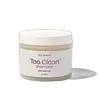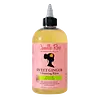What's inside
What's inside
 Key Ingredients
Key Ingredients

No key ingredients
 Benefits
Benefits

 Concerns
Concerns

 Ingredients Side-by-side
Ingredients Side-by-side

Water
Skin ConditioningCocamidopropyl Betaine
CleansingDecyl Glucoside
CleansingSodium Lauroyl Lactylate
EmulsifyingGlycerin
HumectantSorbeth-230 Tetraoleate
EmulsifyingSorbitan Laurate
EmulsifyingGlyceryl Stearate
EmollientArgania Spinosa Kernel Oil
EmollientPanthenol
Skin ConditioningPolyquaternium-10
Aloe Barbadensis Extract
Skin ConditioningPhenoxyethanol
PreservativeCaprylyl Glycol
EmollientSorbic Acid
PreservativeParfum
MaskingZingiber Officinale Root Oil
MaskingDisodium Cocoamphodipropionate
CleansingSodium C14-16 Olefin Sulfonate
CleansingCocamidopropyl Betaine
CleansingCitric Acid
BufferingPimpinella Anisum Seed Oil
MaskingRicinus Communis Seed Oil
MaskingPhenoxyethanol
PreservativeEthylhexylglycerin
Skin ConditioningPolyquaternium-10
Sodium Cocoyl Isethionate
CleansingDecyl Glucoside
CleansingGlycol Distearate
EmollientGuar Hydroxypropyltrimonium Chloride
Skin ConditioningZingiber Officinale Root Oil, Disodium Cocoamphodipropionate, Sodium C14-16 Olefin Sulfonate, Cocamidopropyl Betaine, Citric Acid, Pimpinella Anisum Seed Oil, Ricinus Communis Seed Oil, Phenoxyethanol, Ethylhexylglycerin, Polyquaternium-10, Sodium Cocoyl Isethionate, Decyl Glucoside, Glycol Distearate, Guar Hydroxypropyltrimonium Chloride
Ingredients Explained
These ingredients are found in both products.
Ingredients higher up in an ingredient list are typically present in a larger amount.
Cocamidopropyl Betaine is a fatty acid created by mixing similar compounds in coconut oil and dimethylaminopropylamine, a compound with two amino groups.
This ingredient is a surfactant and cleanser. It helps gather the dirt, pollutants, and other impurities in your skin to be washed away. It also helps thicken a product and make the texture more creamy.
Being created from coconut oil means Cocamidopropyl Betaine is hydrating for the skin.
While Cocamidopropyl Betaine was believed to be an allergen, a study from 2012 disproved this. It found two compounds in unpure Cocamidopropyl Betaine to be the irritants: aminoamide and 3-dimethylaminopropylamine. High-grade and pure Cocamidopropyl Betaine did not induce allergic reactions during this study.
Learn more about Cocamidopropyl BetaineDecyl Glucoside is a glucose-based surfactant and emulsion stabilizer. It is created by reacting glucose with the fatty acids from plants.
Surfactants help clean the skin by trapping oil, sebum, and dirt to be washed away. As an emulsion stabilizer, it stabilizes the ingredients in a product by preventing them from separating.
This ingredient is biodegradable and non-toxic. This ingredient is commonly found in baby shampoos.
Decyl Glucoside is sometimes used to stabilize the UV filter Tinosorb.
Learn more about Decyl GlucosidePhenoxyethanol is a preservative that has germicide, antimicrobial, and aromatic properties. Studies show that phenoxyethanol can prevent microbial growth. By itself, it has a scent that is similar to that of a rose.
It's often used in formulations along with Caprylyl Glycol to preserve the shelf life of products.
Polyquaternium-10 is an ammonium salt of hydroxyethylcellulose. It is a white and granular powder used as a film-former and anti-static agent.
This ingredient is commonly found in hair conditioning products. According to a manufacturer, its positive charge makes it great for absorbing hair proteins. The manufacturer also states this ingredient helps with curl retention.
For haircare friends: this ingredient is not a silicone.
Learn more about Polyquaternium-10